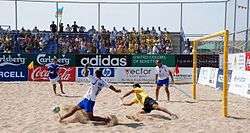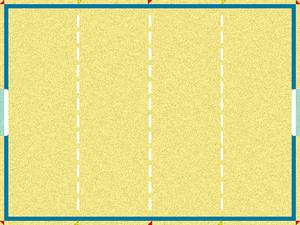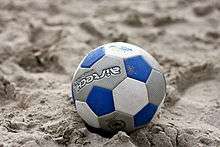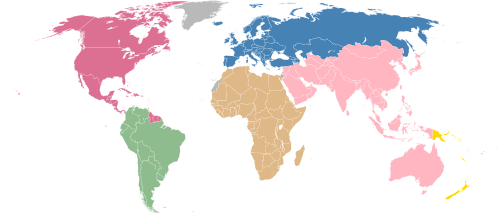Beach soccer
Beach soccer, also known as beach football, sand football or beasal, is a variant of association football played on a beach or some form of sand.
 International match | |
| Highest governing body | FIFA |
|---|---|
| Nicknames | Beach football, beach footie, beasal, futebol de areia, futebol de praia |
| First played | 1992 at Will Rogers Beach, Los Angeles, United States[1] |
| Characteristics | |
| Contact | Yes |
| Team members | 5 at a time |
| Type | Team sport, ball sport |
| Equipment | Football |
| Presence | |
| Olympic | No |
The game emphasises skill, agility and accuracy in shooting at the goal.[2]
Whilst football has been played informally on beaches for many years, the introduction of beach soccer was an attempt to codify rules for the game. This was done in 1992 by the founders of Beach Soccer Worldwide, a company set up to develop the sport and responsible for the majority of its tournaments to this day. This was a major foundation for what is now known as beach soccer and what has led to the sport rapidly growing in popularity.[3]
The irregularity of the soft-sand playing surface leads to a totally different style of play than is used in football, with a greater degree of improvisation. The compact field, much smaller than a normal football field, allows players to score from anywhere on the sand, leading to an average of sixty attempts at goal in a single game. With an average scoring rate of one goal every three or four minutes, around eleven goals are scored in total during an average game.[4]
History
Foundation
Beach football (beasal or futebol de areia) started in Brazil, more precisely at Rio de Janeiro. In 1950 the first official tournament was created to unite neighborhood small tourneys that happened since 1940.[5] After huge popularity it has grown to be an international game. The participation of internationally renowned players such as flamboyant Frenchman Eric Cantona, legendary Spanish strikers Michel and Julio Salinas and Brazilian stars such as Romário, Júnior and Zico has helped to expand television coverage to large audiences in over 170 countries worldwide.
Beach soccer had been played recreationally all over the world for many years and in many different formats. In 1992 the laws of the game were envisioned and a pilot event was staged by the founding partners of BSWW in Los Angeles. By 1993, the first professional beach soccer competition was organized at Miami Beach, with teams from the United States, Brazil, Argentina and Italy taking part.
Growth
In April 1994 the first event to be covered by network television transmissions was held on Copacabana Beach in Rio de Janeiro, and the city hosted the first Beach Soccer World Championship in 1995. The competition was won by the host nation, making Brazil the first-ever World Champions of Beach Soccer. The success of the tournament saw commercial interest begin to match developments on the field, and growing demand for the sport around the world gave rise to the Pro Beach Soccer Tour in 1996.
The first Pro Beach Soccer Tour included a total of 60 games in two years across South America, Europe, Asia and the United States, attracting major names both on and off the field. Interest generated by the tour in Europe led to the creation of the European Pro Beach Soccer League in 1998, providing a solid infrastructure that would increase the professionalism of the spectacle on all levels. The EPBSL, now known as the Euro BS League, brought promoters together from across the continent and satisfied the demands of the media, sponsors and fans. Only four years on from its creation, the successful first step in the building of a legitimate worldwide competition structure for the sport of pro beach soccer had been taken.
Behind the scenes key developments were also taking place, with the Beach Soccer Company relocating its headquarters to Europe, firstly to Monaco and then Barcelona, before becoming Pro Beach Soccer, S.L. in April 2000. One year later they would join forces with Octagon Koch Tavares, who had continued to organise the World Championships and events in South America, to form a single entity known as Beach Soccer Worldwide (BSWW), with the aim of unifying all major Pro Beach Soccer tournaments in the world under the same structure and providing representation of the sport to major sponsors, the media and FIFA.
The EPBSL was also flourishing, a nail-biting 2000 season was decided in the closing match of the final tournament when Spain beat Portugal in an intense encounter. The Americas League also took shape, with teams entered from North and South America, whilst the Pro Beach Soccer Tour extended its horizons to the United Arab Emirates, Thailand, Mexico, Greece, Japan, Australia and the United Kingdom.
FIFA became the global governing body of the sport in 2005, acknowledging BSWW's framework and organizing the first FIFA Beach Soccer World Cup.[6]
Recent years
The next four years would see this growth consolidated by further progress both on and off the field, with the EPBSL emerging as the strongest pro beach soccer competition in the world. By 2004, some seventeen nations had entered teams, with this number expected to rise to over [7] stage events.
Such interest has allowed BSWW to strike major sponsorship deals with international companies including McDonald's, Coca-Cola and MasterCard, who stepped up their involvement in 2004 and are now title sponsors of the Euro BS League. Recognition has also come from FIFA, who have cited BSWW as the major entity behind the creation and growth of Beach Soccer, forming a highly promising partnership that was in its full splendour seen in the 2005 world cup, held in Copacabana Beach, Brazil. France won the first world cup and the next year Brazil won it at the same venue. The World Cup has continued to flourish with the first held outside Brazil in 2008, and future World Cups spreading as far out as Tahiti in 2013 and Portugal in 2015[8]
As of 2017, FIFA and the continental confederations do not host women's beach soccer tournaments. The Asian Beach Games, European Games and South American Beach Games also do not have women's beach soccer tournaments.
Rules
The rules of beach soccer are based on the Laws of the Game of association football, with several modifications.[9]
Field

A beach soccer field is a level sandy area considerably smaller than a regular football field. The field is cleared of pebbles and seashells, along with any other objects which could injure a player.
The field is rectangular in shape, and the touch line is longer than the goal line. The field dimensions are:
- Length: 35–37 metres (38.3–40.5 yards)
- Width: 26–28 metres (28.4–30.6 yards)
The penalty area is within 9 m (9.8 yards) of the goals, and is marked by a yellow flag situated in touch. Two red flags opposite each other are at the center of the field to represent the half-way line. The goals are slightly smaller than their standard association football counterparts, being 2.2 metres (7 ft 3 in) from the ground to the bottom of the crossbar and 5.5 metres (18 ft) in width between the inside of each upright.
Players
Each team consists of five players, including the goalkeeper and an unlimited number of substitutions, from a selection of three to five players. Throw-ins and kick-ins mean the pace and flow of the game are much faster than regular football. Shoes are not allowed; players must play in bare feet, although ankle guards are permitted. Goal clearances (the equivalent of a goal kick) are taken by the goalkeeper using their hands to throw the ball and a goal cannot be scored directly from these.[10]
Match length
A game lasts thirty-six minutes, and is split up into three twelve-minute periods. Unlike association football, in professional matches the referee is not the sole arbiter of the end of a period. A separate timekeeping official controls the official game clock, which is stopped for stoppages in play, and typically counts down to zero, as in North American sports such as basketball and ice hockey. Draws are not permitted, with the game going into three minutes of extra time, followed by a penalty shoot-out if the score is still on level terms after normal time. Unlike football, penalty kicks are directly decided by sudden death rules.
Referees and discipline
Beach soccer has two on-field referees who co-operatively referee the game. They are assisted by a third referee, who acts in a manner similar to football's fourth official and a timekeeper.
As in football, yellow and red cards can be issued. Unlike in football, the team can then bring on a substitute to replace the dismissed player after two minutes.[11] Similar to a power play in ice hockey, this period of numerical advantage ends early if the penalised team concedes a goal.
Free kicks and penalties
Free kicks are awarded for various fouls. All free kicks are direct free kicks which has to be taken by the player who was fouled, unless awarded for deliberate handling. The laws specify that all players apart from the opposing goalkeeper must clear a zone between the kicker and the goal. Because of this and the small playing area, all free kicks represent a good opportunity to score. Penalties are awarded for fouls within the penalty area.
Other major differences from football

- The ball is inflated to a lower pressure (0.4–0.6 atm, compared to 0.6–1.1 atm in football)
- Instead of a throw-in, a team may choose to take a kick-in
- Preventing an opponent doing a bicycle kick is a specific foul
- Teams may not keep possession in their penalty area for more than four seconds
Main beach soccer tournaments
The following are main beach soccer competitions:
International
.jpg)
PRO/Amateur International
- The Beach Soccer Championships – Oceanside, California – USA
- North American Sand Soccer Championships – Virginia Beach, Virginia – USA
Confederation
AFC (Asian Football Confederation):
- AFC Beach Soccer Championship
CAF (Confederation of African Football):
- CAF Beach Soccer Championship
CONCACAF (Confederation of North, Central American and Caribbean Association Football):
- CONCACAF Beach Soccer Championship
CONMEBOL (South American Football Confederation):
OFC (Oceania Football Confederation):
- OFC Beach Soccer Championship
UEFA (Union of European Football Associations):
- Euro Beach Soccer Cup
- Euro Beach Soccer League
- UEFA Beach Soccer Championship
- BSWW Euro Winners Cup
References
- "The History and Growth of Pro Beach Soccer (1992 to Present)". beachsoccer.com. 2001. Archived from the original on February 15, 2002. Retrieved 28 April 2016.
- "BBC – Manchester – Life's a beach in Tameside". BBC News. 2009-08-14. Retrieved 2012-10-03.
- Pickup, Oliver (2013-09-04). "Sand Aliens & Heel Flicks: Introducing The England Beach Soccer Team". Sabotage Times. Archived from the original on 2014-04-08. Retrieved 2014-05-14.
- Garry, Tom (2014-11-03). "Women's Beach Soccer: Sun, sea, sand, bicycle kicks and a European Championship". BBC Sport. Retrieved 2016-07-31.
- "Projeto de Lei 2102/2016 - Clause 2102/2016". Câmara do Rio de Janeiro.
- "FIFA Beach Soccer World Cup". www.beachsoccer.com. Retrieved 2018-07-06.
- twenty for the Euro BS League in 2005, contributing to vastly expanded television coverage of the series and unprecedented demand from promoters in more than seventy countries looking to
- Borkakoty, Rituraj (November 21, 2013). "Beach soccer is bigger than beach volleyball: Cusco". Khaleej Times.
- "BEACH SOCCER - Laws of the Game 2015/2016" (PDF). FIFA.com. FIFA. Retrieved 5 July 2018.
- "BBC – The Guide: What's on in Somerset". BBC News. 2009-08-13. Retrieved 2012-10-03.
- "FIFA booklet – Beach Soccer Laws of the Game (2006)" (PDF). Images.ussoccer.com. Archived from the original (PDF) on 2009-03-25. Retrieved 2012-10-03.
External links
| Wikimedia Commons has media related to Beach soccer. |

.svg.png)